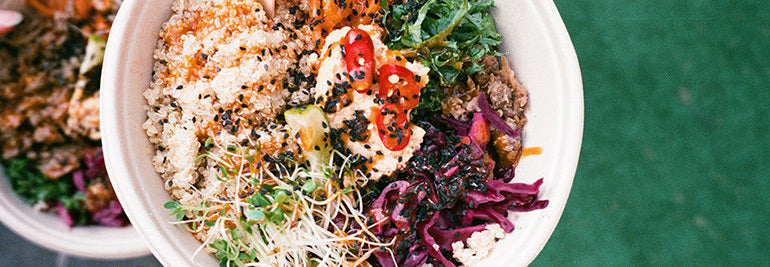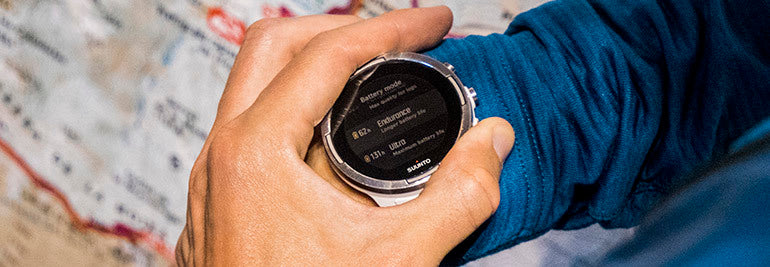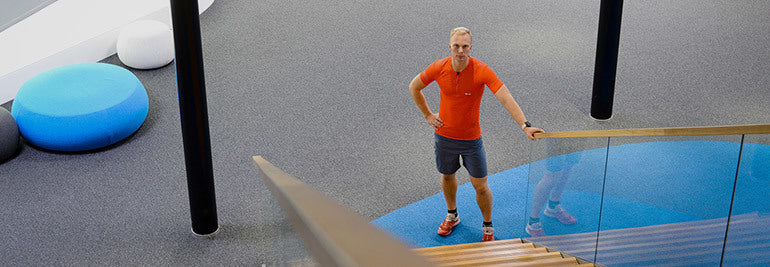

SUUNTOブログ

Fuelling the engine: a commonsense approach to nutrition
Eating well is essential for athletes. The bigger your goal, the more nutrition has to play a central part of your training plan. Take shortcuts on how you eat, and you’ll eventually pay for it.
But the topic of diet, what we should and shouldn’t eat, has become touchy and confusing. There are all sorts of diets out there – paleolithic, vegan, gluten-free, low carb, high carb – each one with advocates claiming their way is the one true way.
Matias Anthoni prefers a common sense approach to nutrition.
“Nowadays it’s become a big topic, and everyone has his or her own opinion, and it seems hard to find the real truth,” says Matias Anthoni, Suunto’s in-house personal trainer. “It’s become trendy to follow a kind of diet.”
Anthoni, 26, has a Bachelor in Sports and Health Promotion, and gives nutritional advice to Suunto employees, as well as personal fitness training. He takes a simple, “nonsectarian” approach to nutrition, rather than buying into the hype of one diet over another.
“As long as you get the nutrients it doesn’t really matter what diet you follow,” he says. “You can teach your body to thrive on different diets. The body is quite adaptable. But we do need certain basics. The question I always ask is, would my grandma recognize it as food?”
Here are Anthoni’s five down-to-earth tips for good nutrition:
1. Start with your meal rhythm
This is the first topic Anthoni’s raises with his clients during a consultation. Just improving how often you eat can improve what you eat. Many of his clients skip meals or have long breaks between meals; this results in blood sugar levels dropping, then tiredness, and then cravings and impulses for unhealthy snacks.“With a more steady meal rhythm you avoid big spikes in the blood levels, make better decisions, and are less likely to just reach for a chocolate bar,” he says.
Meals should be about three hours apart, and consist of a good breakfast, lunch and dinner, with smaller, healthy snacks in between. “It leads to healthier choices and you’ll have more energy,” Anthoni says.
2. Plan ahead
“You can’t be a top athlete if you are eating poorly; it’s not just about training, it’s about eating as well,” Anthoni says. “It really helps if you plan your meals like you plan your training. Know what you are going to buy and know what you are going to make. When you come home from work, or after a training session, it’s all ready to go.”
3. Follow the Nordic plate model
Anthoni says in Finland there’s a traditional “plate model” or a way to divide your plate into three sections: one half should be salad and vegetables, one quarter should be carbohydrates, and one quarter protein. This balanced plate ensures you will get enough of all the key nutrients.
4. Eat quality food
Quality can seem like a vague notion, so Anthoni recommends a common sense approach here, too. “Have a look at your plate – are there all the colours – red, green, yellow?” he asks. “Are you eating the same thing every day?” Anthoni suggests finding and following basic nutrition guidelines. “They provide a good start, and then make small changes to fit yourself from there,” he says.
5. There’s no one size fits all diet
Deciding what to eat depends on your goals. “The more you move the more you need,” Anthoni says. “If your goal is building muscle mass, then you need more protein. If you are an endurance athlete, eating enough carbohydrates becomes more important. There is no one size fits all, no one plan can fit everyone. You need to have your own plan.”
Lead image: Photo by Roosa Kulju on Unsplash.
READ MORE
Fuelling the engine: talking nutrition with ultra runner Lucy Bartholomew
Fuelling the engine: talking nutrition with triathlete Mel Hauschildt

Fuelling the engine: talking nutrition with Melissa Hauschildt
Buying good quality and diverse produce and preparing nutritious meals is as important for our training as time spent running, cycling, swimming or at the gym. Yet, for many of us – especially for those of us with full time jobs and families – it’s tempting to cut corners when it comes to diet. We tell ourselves “next time”, and whip up a fast meal that fills the hole, but doesn’t fuel the engine.
Training is all about consistency and honesty. We shouldn’t try to fool ourselves; when we cut corners we don’t really gain in the long run. Instead, the training lifestyle is all about dedication to our sport, and the truth is, at the heart of that is caring for our bodies.
In this series of posts we explore how Suunto ambassadors and athletes keep their tanks fuelled. In this second instalment, we meet another Australian athlete, Melissa Hauschildt, an Ironman champion who recently set a new world record for fastest time (8:31:04) at the Ironman North American Championships, Texas in April.
The long term outlook
Good nutrition is a major part of Hauschildt’s life. Racing in Ironmans all over the planet, as the 35-year-old does, demands she feeds her engine with only the best fuel. “To be the best athlete I can I need to fuel my body correctly, but it's also important for life after sport,” she says. “I want to stay fit and healthy so I eat a healthy balanced diet.”
Maintaining good diet in busy times
Eating healthy can easily go out the window in busy times – how does Hauschildt maintain it? She prepares ahead of time. “I always have a healthy snack ready to go – nuts are always in abundance in my house, as well as bananas and apples,” she says. “I make almond butter and buckwheat bread at the start of the week so that’s always provides for great quick and easy snacks – almond butter and banana on toast or almond butter on apple.
“I also use Megaburn products. They make the best protein bars, with all natural ingredients, and so delicious! I always have a stack of them in the house. If I know it’ll take a while to make a meal after training, I will have a Megaburn protein shake immediately after so I can then take my time making a nutritious meal and not snack on junk.”
Natural is best
“I try to eat foods in their most natural form. I eat a lot of salad and vegetables, meat, nuts and eggs. I only eat full fat dairy. I make my own healthy treats as well, as my own bread and almond butter. I try to avoid packaged foods and refined sugar. I avoid soy, lentils, anything labeled ‘low fat’ or ‘diet’ and limit grains. I eat a lot of good fats - butter, olive and coconut oil, avocado, nuts, seeds, eggs.”
Easy, go-to meals
“My easy go-to meals tend to be a large salad with some meat. If I don't have any meat in the fridge I always have canned tuna and sardines in the cupboard or eggs. Another quick and easy go to meal for me is an omelette loaded with salad and left over meat or tuna.”
Kangaroo rice bowl
Ingredients:Wild riceKangaroo filletsRocketRed onionSnow peasTomatoShallotsCorianderAvocadoBlue cheeseOlive oilLime
Directions:
1. Cook rice to packet instructions. BBQ kangaroo fillets to medium/rare. Kangaroo gets very tough if overcooked. 2. Pre cut salads.3. Mix some olive oil and lime juice together for dressing. Grate some lime rind.4. Place cooked rice in bowl then arrange cut salads over it. Crumble some blue cheese on top. Sprinkle with lime rind. Pour over dressing.
Lead image: Photo by Ive Erhard on Unsplash.
READ MORE
Fuelling the engine: Talking nutrition with trail runner Lucy Bartholomew

Get your Suunto 9 ultra ready
With its 110 km distance and 6800 m of vertical ascent, Ultra Pirineu is the longest ultra race Marc has ever run. Kilian Jornet has set the course record in just over 12 hours. Marc knows he is venturing into unknown territory so he hasn’t set a specific time goal.
Marc has created a custom trail running sport mode for Ultra Pirineu.
“As for how I will 'race' it – I won’t be racing like Kilian that’s for sure!” Marc says. “I plan to start slow, control the adrenaline and be comfortable for the first two-thirds of the race. That’s why I find heart rate important to me, so I can see my real-time effort. Being present in the moment is equally important, because in long distance running you can't get too caught up in what's ahead.”
To help him make the finish line in good time, Marc will be using his in-depth knowledge from working at Suunto in product information management to get the very best from his Suunto 9.
Suunto 9 takes a lot of hassle out of optimizing your GPS watches battery life for a long event: it provides three predefined battery modes – Performance, Endurance and Ultra – that give you up to 120 hours of GPS tracking time. GPS accuracy is the biggest difference between the modes. You can also create a custom battery mode with your Suunto 9.
Suunto 9 has three predefined battery modes – Performance, Endurance and Ultra – and you can also define your own custom settings.
“Suunto 9’s intelligent battery modes are great,” Marc says. “You have one less thing to think about and can just enjoy the trails and views. I’ve created a custom battery mode that is based on the performance mode; I turn all vibration and notifications off, disable the auto-lap feature, whilst also changing the display to 'low color' and display timeout on.”
“If I end up taking longer than I expect switching from race mode to 'just getting the race done mode', then my watch will also switch to a better battery mode on the go, so it really is a companion that is appreciated and valuable.”
To make sure Marc doesn’t accidentally run out of battery, his Suunto 9 will ask if he would like to change to another battery mode should the power drop below 10 %. One thing is sure, on race day Marc is going to be fully ready.
“I've come here to push my limits, experience something new and see some wonderful scenery and that’s not to mention meeting all the wonderful people that go along in an event,” he says.
Good luck, Marc and everyone else running the Salomon Ultra Pirineu!
Learn How to get the most of Suunto 9’s battery modes
Read Suunto 9’s user guide

Fuelling the engine: talking nutrition with Lucy Bartholomew
"I really try to use the time and an accessibility I have to create food that will bring out the best in me,” Lucy says.
Being an athlete is all about discipline and consistency. We usually think of these in terms of training – getting out the door, whether we feel like it or not, day after day, week after week.
How we eat is often religated to a secondary factor; nice, but not as valuable as the training part. Napolean Bonaparte's famous statement, "an army marches on its stomach", suggests otherwise – food is what carries us forward. And the more nutritious it is, the better we will perform.
In this series of posts we explore how Suunto ambassadors and athletes keep their tanks fuelled. First up, Australian ultra runner Lucy Bartholomew shares her passion for a plant-based diet.
Running on a plant-based diet
© Lucy Bartholomew
Lucy Bartholomew, 22, recently completed the 100-mile Western States Endurance Run, and she did it on a vegan diet. This means she gets to eat lots of fruit and vege, her favorite thing next to being on the trail.
“As an athlete I think that you are what you eat and the fuel you put into your engine is the performance you will receive so I really try to use the time and an accessibility I have to create food that will bring out the best in me,” Bartholomew says. “I love the way that different food and recipes work for different people, how you can share this form of culinary artwork and always give a unique twist with your own personality.”
Go to, easy meals
The green smoothie, or “Shrek poo”, is one of Bartholomew's staple meals. Photo by Kimber Pine on Unplash.
“My favorite thing to create for myself and others is a Buddha bowl. You have probably never heard of it and that's the best thing about; it isn't anything specific it's just a bowl filled with goodness and plants. I usually enjoy some baked sweet potato in there, a bean of some sort, a nut-based salad dressing and an abundance of raw and cooked vegetables.
“My morning go-to is a smoothie bowl that is a thick smoothie made with frozen bananas and is usually green because I add spinach and other vegetables to keep my body loaded with nutrients. I usually top this with more fruit, nuts and seeds.”
Having the essentials on hand
“I have learned about the importance of being organized and making time to prepare food,” Bartholomew says. “I always carry with me my ‘essentials’ that I can easily survive off on the go. These things include rolled oats, greens powder, nut butter and nutritional yeast. Along with these, I pick up and whatever fruit and vegetables I can get my hands on and then I'm a very happy little camper.”
Direct from the earth
“I really believe that 'you are what you eat' and the more you can eat directly from the earth, and without the packaging, the better the food will make you thrive.”
Lucy's Buddha bowl
One of Bartholomew's Buddha bowls. © Lucy Bartholomew
IngredientsSweet potato, chopped in chunksRed cabbage, roughly choppedCarrot, gratedBeetroot gratedChickpeas, drained and rinsedCooked rice/quinoaBroccoli, any veg!TurmericCayenne pepperSalt and pepperHummusTahini, miso, turmeric dressingYou could also add some boiled eggs, meat, tofu, fish
Method
Bake the sweet potato in the oven at 180° C for 30 minutes. I like to bake my potato without oil, but if you like it a bit moister then add some oil.
Place drained chickpeas onto a baking tray and sprinkle with some turmeric, cayenne pepper, salt or any spice you choose. Roll them around to pick up all the spice and flavors and also place in the oven with the sweet potato for 20 minutes or until crispy.
Steam any vegetables or prepare other veggies you have decided to use.
Place cabbage, beetroot, carrot and cooked grains, additional veg into a serving bowl. Add sweet potato and chickpeas when ready. Top with hummus, tahini dressing or your own versions! And enjoy!
Lead image: Photo by Dan Gold on Unsplash.

Make everything count: 7 tips for office workers to get moving
At Suunto headquarters in Finland we try to practice what we preach. Which is why we have an in-house personal trainer to motivate us all to stay fit and healthy.
Matias Anthoni, 26, roams the offices, dropping by rooms, calling on us to get up and to join him for short exercise breaks on the spot. Resistance is futile!
Matias sees stairs as an opportunity to stay active.
“My job is to maintain the health and wellbeing of everyone at Suunto,” the former footballer turned trail runner says. “Everyone who works for the company can use me free of charge. I offer group exercise classes, personal sessions, nutritional advice, and random exercise breaks. Everyone understands it’s a great opportunity.”
Matias has a Bachelor in Sports and Health Promotion, and believes there are many opportunities throughout the day for office workers to take care of their bodies and minds. Here are his tips:
1. Everything counts
Remember this phrase and make it your mantra. It cuts through all the excuses about not having time. Sometimes we get stuck in an “all or nothing” mindset; if we can’t, for example, go for an hour long run or a full gym workout, we don’t do anything at all, failing to see the possibilities that are often right in front of our faces, and don’t take much time. Matias says it’s about thinking laterally, and making everything count.
2. Three x three minutes
Take three, three-minute exercise breaks a day. Set a timer on your phone, and do it. Invite your colleagues to join you. To get you started, here’s a short video of Matias demonstrating a few simple movements – try them! “Getting the blood flowing is good for the brain,” Matias says.
3. Go out of your way
When you need to go to the bathroom or get water or coffee, rather than going to the closest option, get in some extra movement and take an extra flight of stairs to do what you need on a floor above or below. Go out of your way for the sake of a little extra movement. It all counts.
4. Have walking meetings
When you have a simple catch up meeting that doesn’t require technology, why not make it a walk and talk? Aside from the movement, people are generally less distracted and more engaged at a walking meeting. You’ll breathe better, and will feel more energized.
5. Use your lunch breaks wisely
Have a 25 or 30-minute workout before you have lunch and you’ll have more energy for the rest of your day. It could even be 15 minutes. Remember, everything counts. Do what you can, rather than getting stuck in what you can’t. “Studies show a small amount of exercise goes a long way,” Matias says.
6. Create team challenges
Try to create a culture where you encourage one another to stay active. Create a challenge to see which department or team can do the most pull-ups in a month, or can walk the most steps in a month.
7. Plan your day
When you plan your day in advance you will know when you have windows for exercise or movement breaks. Planning means you are more likely to take advantage of these. Lock them in, and make them count.

5 life lessons learned from running the Great Himalayan Trail
© Dean Leslie / Red Bull Content Pool
The Ultra Trail Mont Blanc (UTMB), considered the world’s premiere ultra race, has haunted 36-year-old South African athlete Ryan Sandes since 2015.
The last three times he attempted it, “trail karma” got the better of him: first glandular fever knocked him out, the second time he dropped out after 40 km due to a stomach infection, and in 2017 he finished in the top 20, but only after soldiering through the race with dead legs.
Now he’s in Europe training in the Alps to give it another shot in late August, and this time something has changed – his attitude. For the build up to UTMB, Sandes ran the Stubai Ultra – 63 km, 5075 m ascent. Unfortunately, he had pull out of the race early. “That didn’t go according to plan,” he said on Instagram. “It seems my climbing legs are still in the Himalayas. I was pretty disappointed to cut my race short.”
© Dean Leslie / Red Bull Content Pool
In spite of this, and his previous bad luck on the UTMB, Sandes is feeling unusually relaxed. He puts it down to some of the hard lessons he learned while smashing the Fastest Known Time (FKT) on the Great Himalayan Trail with Ryno Griesel in March this year.
“In the past I put too much pressure on myself at the UTMB with time and results,” Sandes says. “Now I just want to enjoy the process.
“I want to do the best I can, but there’s only so much you can do. You can’t get too freaked out. I don’t want to look back 10 years from now, and say, ‘yeah, I ran UTMB, but I hated most of it because I was too fixated on the result.
“I want to enjoy the overall experience. The end goal is just a byproduct.”
Here are Sandes’s life five lessons from the Great Himalayan Trail:
© Dean Leslie / Red Bull Content Pool
1. Break things down into bite size chunks
“For ultras, it might be from one aid station to the next,” Sandes says. “For normal life projects, like building a house, find a similar way to try to wrap your head around it. Sometimes I think too far ahead, and then I get stressed. On the Great Himalayan Trail I was forced to take it day by day – it was too big to do otherwise. It was cool learning to be really present and in the moment.”
2. Be generous
“The Nepalese people are incredible, how welcoming and supportive they are. It taught me one small thing you do can make a big difference in a person’s life. It’s all about being thoughtful. Nepalese in the mountains live a basic life, but they are super family orientated and friendly. It was quite a big reminder for me, especially now I have baby boy. In the west, everything is so quick and busy, that we sometimes forget to prioritise family. It reminds me to keep things simple.”
3. Focus on the small things in life
“In modern society we have massive goals, it’s shoot for the moon, which is important, but it’s also about being content with the smaller things in life. I get so hell bent on a race, I neglect family and the small things in life. We can become so driven sometimes that life can feel empty. It’s about balance, and appreciating small pleasures.”
4. Don’t overthink it
“I learned I’m a little bit of a control freak. It taught me there are so many things I can’t control. With life in general, it’s the person who can think on his feet who does the best. You need to be responsive to what life throws at you. In the Himalayas, we had quite a detailed plan in place, but everyday everything went out the window. It was pretty cool. Don’t overthink and freak out – you won’t enjoy yourself.”
5. Focus on the positive
“In the Himalayas, I had a two day period when I was really missing home. Interestingly, that was the toughest time for me physically. The physical follows the mental. To counteract this I told myself that it was a one off opportunity, it was my decision to be there, and lots of people dreamed of doing what I was doing. I also focused on the scenery and interacting with the locals. That definitely improved things.”
Lead image credit: © Dean Leslie / Red Bull Content Pool






























































